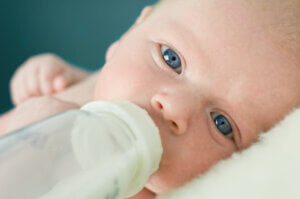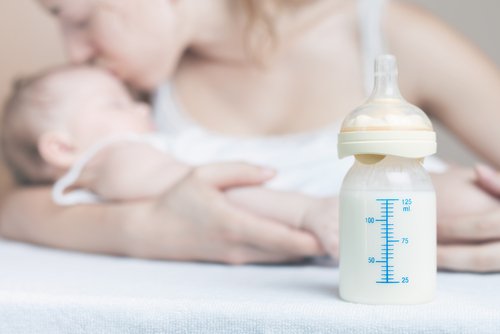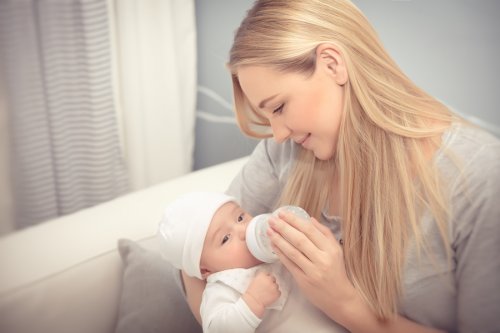What Are Anti-Colic Bottles for Babies?


Reviewed and approved by the doctor Nelton Ramos
Mothers should ideally breastfeed their babies exclusively for the first six months of life. However, there are certain circumstances where it’s just not possible, and they find another way to cover their baby’s nutritional needs. When that happens, anti-colic bottles are an excellent option.
Bottles have been one of a mother’s best allies for many years – whether it be from birth or after the sixth month. Baby bottles have evolved over the course of history in order to better fit the nutritional needs of babies without causing issues.
Choosing the right bottle for your infant isn’t something you should leave up to chance. If you don’t look for the right characteristics, you could end up causing your child to be colicky.
This is because some bottles allow air to sneak in between a baby’s lips and the bottle’s nipple. Therefore, rather than serving as a solution, these bottles actually become the source of a problem.
When you look at the infinite options that are available on the market, any parent can feel overwhelmed. It’s important to know just what you need to look for. That’s why we suggest narrowing your options down to anti-colic bottles.
What are anti-colic bottles?
Anti-colic bottles have arrived on the market to resolve an issue that has plagued small children for ages. This type of baby bottle allows air to enter into the bottle as babies drink the contents. That way, babies can easily regulate the rhythm with which milk exits the bottle.
How do they work?
Within the spectrum of anti-colic bottles for babies, you’ll find a variety of options. In some cases, they have two holes in the nipple.
This facilitates the entrance of air into the bottle without affecting the milk. At the same time, it makes it easy for children to suckle. That is exactly what produces those painful abdominal contractions known as colic.
The secret to this product lies in the tube located in the neck of the bottle. This allows air to flow directly to the bottom of the bottle. Therefore, babies can drink peacefully, without bubbles forming in the milk that can end up in their bellies and cause pain.

How to choose anti-colic bottles?
When you’re in need of a baby bottle, keep in mind some recommendations to choose the best of the best:
- The bottle should be easy to use and practical. Remember, this is something you’ll be using numerous times on a daily basis. Don’t get carried away with cute images and trendy designs if the bottle’s functionality isn’t useful.
- Evaluate how easy the bottle is to wash and sterilize. This will make it easier to keep the bottle clean at all times.
- Pay close attention to the materials and processes used to make the bottle. During the first months of life, babies drink only a little at a time, and you’ll need to hold the bottle. However, when babies get older, they can hold bottles for themselves. Therefore, choose an anti-colic bottle that will be comfortable in both cases.
- Even when the design of a baby bottle is ergonomic, the surface should be as smooth as possible.
- When choosing the right nipples, keep your baby’s age in mind. This will determine which nipple is best suited for your little one in regards to the material, shape and holes.
“In some cases, anti-colic bottles have two holes in the nipple. This facilitates the entrance of air into the bottle without affecting the milk. At the same time, it makes it easy for children to suckle.”
Characteristics and types
An infinite number of brands currently offer good options when it comes to anti-colic bottles. The characteristics that differentiate one bottle from the next are the following:
Thermal resistant glass bottles
These bottles are easy to wash and don’t hold in any odors. However, it’s important to point out their disadvantage.
Glass bottles are, as you may have guessed, fragile and heavy, both for moms and babies. When babies can start holding bottles on their own, glass might not be the safest or most comfortable option.
Unbreakable plastic bottles
These bottles offer greater safety, especially when babies are ready to feed themselves.
As far as disadvantages, we have to mention that these bottles easily lose their aesthetic appeal because they’re prone to scratches. They also tend to absorb the smell of food easily, making it harder to maintain hygiene.
Shapes and sizes
For the first months of a child’s life, bottles with a capacity of 3 or 4 ounces will be enough. As babies grow, they’ll need a bigger bottle – between 8 and 12 ounces.
As for the shape of baby bottles, there are a number of alternatives:
- Cylindrical: This is the most classic bottle shape and is practical for any use.
- Triangular: Easy to wash and very stable to hold.
- Wide: Their large opening makes pouring milk or water in much easier.
- Angular/anti-reflux: These bottles have a special inclination that allow for more even suctioning and don’t allow air to come in.
- Ergonomic: Their main benefit is that they’re easier for babies to hold on to.

Bottle nipples
Just like the world of baby bottles, the world of bottle nipples is very broad when it comes to their characteristics.
You can choose between latex and silicone, as well as a variety of shapes. These offer true comfort when it comes to suctioning. Lastly, nipples may contain one or more holes.
The variety of anti-colic bottles that are available for babies is immense. However, the best option will be that which satisfies your baby’s needs, providing well-being in terms of nutrition and hydration
Don’t be easy prey to commercials and gimmicks. Rather, look for something that’s useful, easy to clean, and manageable for both you and your baby.
Mothers should ideally breastfeed their babies exclusively for the first six months of life. However, there are certain circumstances where it’s just not possible, and they find another way to cover their baby’s nutritional needs. When that happens, anti-colic bottles are an excellent option.
Bottles have been one of a mother’s best allies for many years – whether it be from birth or after the sixth month. Baby bottles have evolved over the course of history in order to better fit the nutritional needs of babies without causing issues.
Choosing the right bottle for your infant isn’t something you should leave up to chance. If you don’t look for the right characteristics, you could end up causing your child to be colicky.
This is because some bottles allow air to sneak in between a baby’s lips and the bottle’s nipple. Therefore, rather than serving as a solution, these bottles actually become the source of a problem.
When you look at the infinite options that are available on the market, any parent can feel overwhelmed. It’s important to know just what you need to look for. That’s why we suggest narrowing your options down to anti-colic bottles.
What are anti-colic bottles?
Anti-colic bottles have arrived on the market to resolve an issue that has plagued small children for ages. This type of baby bottle allows air to enter into the bottle as babies drink the contents. That way, babies can easily regulate the rhythm with which milk exits the bottle.
How do they work?
Within the spectrum of anti-colic bottles for babies, you’ll find a variety of options. In some cases, they have two holes in the nipple.
This facilitates the entrance of air into the bottle without affecting the milk. At the same time, it makes it easy for children to suckle. That is exactly what produces those painful abdominal contractions known as colic.
The secret to this product lies in the tube located in the neck of the bottle. This allows air to flow directly to the bottom of the bottle. Therefore, babies can drink peacefully, without bubbles forming in the milk that can end up in their bellies and cause pain.

How to choose anti-colic bottles?
When you’re in need of a baby bottle, keep in mind some recommendations to choose the best of the best:
- The bottle should be easy to use and practical. Remember, this is something you’ll be using numerous times on a daily basis. Don’t get carried away with cute images and trendy designs if the bottle’s functionality isn’t useful.
- Evaluate how easy the bottle is to wash and sterilize. This will make it easier to keep the bottle clean at all times.
- Pay close attention to the materials and processes used to make the bottle. During the first months of life, babies drink only a little at a time, and you’ll need to hold the bottle. However, when babies get older, they can hold bottles for themselves. Therefore, choose an anti-colic bottle that will be comfortable in both cases.
- Even when the design of a baby bottle is ergonomic, the surface should be as smooth as possible.
- When choosing the right nipples, keep your baby’s age in mind. This will determine which nipple is best suited for your little one in regards to the material, shape and holes.
“In some cases, anti-colic bottles have two holes in the nipple. This facilitates the entrance of air into the bottle without affecting the milk. At the same time, it makes it easy for children to suckle.”
Characteristics and types
An infinite number of brands currently offer good options when it comes to anti-colic bottles. The characteristics that differentiate one bottle from the next are the following:
Thermal resistant glass bottles
These bottles are easy to wash and don’t hold in any odors. However, it’s important to point out their disadvantage.
Glass bottles are, as you may have guessed, fragile and heavy, both for moms and babies. When babies can start holding bottles on their own, glass might not be the safest or most comfortable option.
Unbreakable plastic bottles
These bottles offer greater safety, especially when babies are ready to feed themselves.
As far as disadvantages, we have to mention that these bottles easily lose their aesthetic appeal because they’re prone to scratches. They also tend to absorb the smell of food easily, making it harder to maintain hygiene.
Shapes and sizes
For the first months of a child’s life, bottles with a capacity of 3 or 4 ounces will be enough. As babies grow, they’ll need a bigger bottle – between 8 and 12 ounces.
As for the shape of baby bottles, there are a number of alternatives:
- Cylindrical: This is the most classic bottle shape and is practical for any use.
- Triangular: Easy to wash and very stable to hold.
- Wide: Their large opening makes pouring milk or water in much easier.
- Angular/anti-reflux: These bottles have a special inclination that allow for more even suctioning and don’t allow air to come in.
- Ergonomic: Their main benefit is that they’re easier for babies to hold on to.

Bottle nipples
Just like the world of baby bottles, the world of bottle nipples is very broad when it comes to their characteristics.
You can choose between latex and silicone, as well as a variety of shapes. These offer true comfort when it comes to suctioning. Lastly, nipples may contain one or more holes.
The variety of anti-colic bottles that are available for babies is immense. However, the best option will be that which satisfies your baby’s needs, providing well-being in terms of nutrition and hydration
Don’t be easy prey to commercials and gimmicks. Rather, look for something that’s useful, easy to clean, and manageable for both you and your baby.
All cited sources were thoroughly reviewed by our team to ensure their quality, reliability, currency, and validity. The bibliography of this article was considered reliable and of academic or scientific accuracy.
- Jiménez, S. G. (2019). Cuidados básicos del recién nacido. El farmacéutico: profesión y cultura, (573), 26-32.
- Moreno, J. P., Calatayud, G. Á., & Hernani, M. T. (2015). Patología funcional digestiva en niños pequeños. Cólico del lactante. PATOLOGÍAS Y PROBLEMAS PREVALENTES EN EL NIÑO, 29. https://www.sepeap.org/wp-content/uploads/2015/10/ACTION.-Patologias_Monografia.pdf#page=31
- Rasquin A, Di Lorenzo C, Forbes D, et al. (2006). Childhood functional gastrointestinal disorders: childl/adolescent. Gastroenterology 2006; 130:1.527-37.
This text is provided for informational purposes only and does not replace consultation with a professional. If in doubt, consult your specialist.








